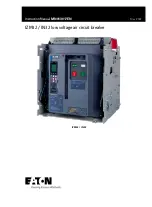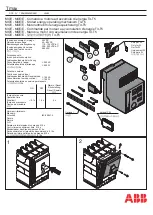
2
IZM32 / IN32 low voltage air circuit breaker
MN013017EN May 2022 www.eaton.com
Section 1: Introduction
1-2 Safety features
IZM32 / IN32 circuit breakers and associated drawout
equipment are manufactured with built-in interlocks and
safety-related features. They are provided to reduce hazards
to operating personnel and provide proper operating
sequences.
A
B
C
D
21
IZM32H3-V32W-1
3200A
A) Low Voltage Air Circuit Breaker Family
Name
B) Breaker Family Size in Amperes
C) Interrupting Capacity Rating
D) Factory Equipped Accessories
Figure 1-2 Typical IZM32 / IN32 nameplate
WARNING
Type IZM32 / IN32 circuit breakers are robust and
are provided with safety features. nevertheless, the
voltages, currents, and power levels available in and
around this equipment when it is in operation are
extremely dangerous and could be fatal. under no
circumstances should interlocks and other safety
features be made inoperative, as this may result in
death, bodily injury, or property damage.
1-3 Safe practices
To protect personnel associated with the installation,
operation, and maintenance of this equipment, the following
practices must be followed:
1. Only qualified electrical personnel familiar with the
equipment, its operation, and the associated hazards
should be permitted to work on the equipment.
Additionally, only qualified personnel should be
permitted to install or operate the equipment.
2. Always be certain that the primary and secondary
circuits are de-energized or the circuit breaker is
removed to a safe work location before attempting any
maintenance.
3. For maximum safety, only insert a completely
assembled breaker into an energized cell.
4. Always ensure that drawout circuit breakers are in one
of their designed cell positions, such as CONNECT,
TEST, DISCONNECT, or REMOVE. A circuit breaker
permitted to remain in an intermediate position could
result in control circuits being improperly connected,
resulting in electrical failures.
1-4 Qualified personnel
For the purpose of operating and maintaining low voltage air
circuit breakers, a person should not be considered qualified
if the individual is not thoroughly trained in the operation of
the circuit breaker and how it interfaces with the assembly
in which it is used.
For the purpose of installing and inspecting circuit breakers
and their associated assembly, a qualified person should
also be trained with respect to the hazards inherent to
working with electricity and the proper way to perform
such work. The individual should be able to de-energize,
clear, and tag circuits in accordance with established safety
practices.
WARNING




























